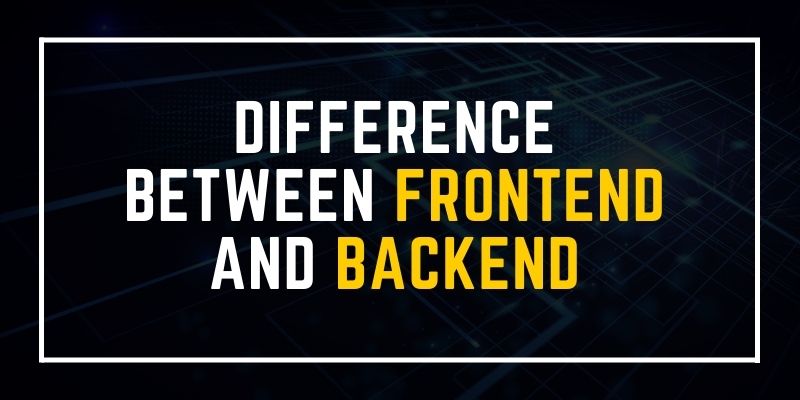
Frontend and Backend are the two most favoured terms for web design. These terms are crucial to web development. However, they differ from one another. Each of them must be able to communicate effectively and effectively as a team to increase the website’s efficiency.
Front-End Development: This portion of a site that users interact with directly is the front-end. It’s also known as the “client side” of the software. It comprises everything users can see, including styles and colours for text graphs, images, buttons, table colours, and navigation menus. HTML, CSS, and JavaScript are the main languages used in Front End development.
The design, structure, behaviour, and content of what is displayed on the screen of a browser when web-based websites, web applications, or mobile applications are opened are created by front-end developers. To get extensive coding knowledge in frontend and backend languages, fetch with Full Stack Developer Course in Chennai.
Performance and responsiveness are the two major goals for Front End developers. Front End. The developer should make sure that the site has a responsive design i.e. it displays correctly across all sizes of devices. Every part of the site will behave differently, irrespective of the screen’s size.
Front-end languages: This front end is constructed by using a variety of languages that are described in the following sections:
- HTML: HTML stands for Hypertext Markup Language. It is used to create the front-end part of web pages by using the markup language. HTML is the result of combining Hypertext with Markup language. Hypertext is the language that defines the link between web pages. Markup technology defines the text documentation inside the tag that determines how web pages are structured.
- CSS: Cascading Style Sheets, often known as CSS, is a simple language designed to ease the creation of attractive web-based pages. CSS lets you apply a style to web pages. In addition, CSS enables you to apply this without regard to HTML, which is the basis of every website page.
A variety of other languages allow you to develop front-end applications based on the framework, for instance, Flutter. Dart and React use JavaScript, and Django uses Python and many more.
Front End Frameworks and Libraries:
- AngularJS: AngularJs is a JavaScript open-source front-end platform used to develop simple-page internet applications(SPAs). It is a constantly growing and expanding framework that provides more efficient methods for creating web-based applications. It converts static HTML into dynamic HTML. It is an open-source project that is cost-free. It expands HTML attributes with Directives, and data is tied to HTML.
- React.js is a declarative, efficient, and adaptable JavaScript library to create user interfaces. ReactJS is an open-source front-end that uses components and is only responsible for the views layer of the application. ReactJS is managed and maintained by Facebook.
Backend Development Backend serves as the site’s server. It is where you can store and organize information and ensure that everything on the client side of the website is working properly. It is the portion of the site that users cannot interact with. It is the part of the software that doesn’t interact directly with users. The components and features designed by backend designers are accessible to users via a front-end application. Examples of this include the creation of libraries, writing APIs, and working with system components that do not have user interfaces, or the systems for scientific programming are included in the backend.
Back End The language used is: The back end is constructed using a variety of languages that are described in the following sections:
- PHP: PHP is a server-side scripting programming language specifically developed intended for the web. Because PHP scripting code executes on the server side, it is called the server-side language for scripting.
- C++: It is an all-purpose programming language that is frequently used for competition programming. It can also be used as a backend language.
- Java: Java is one of the most well-known and extensively used programming languages and platforms. It’s extremely adaptable. Java components are readily accessible.
- Python: Python is a programming language that allows you to perform tasks quickly and connect systems more efficiently.
- JavaScript: JavaScript can be used in both (front end and backend) programming languages.
Get hands-on experience in all the front and backend languages by joining the Full Stack Developer Online Course and getting detailed knowledge.
Back-End Frameworks:
- The back-end frameworks include Express, Django, Rails, Laravel, Spring, and more.
- The other back-end scripting languages include C# Ruby as well as REST. Go, etc.
The difference Between Frontend and Backend: Frontend and backend development differ, but nonetheless, they’re two different aspects of the same issue. The front end is what the users encounter and interact with, and the back end controls how things work.
- The front end is the website area that users view and interact with, such as the graphic user interface (GUI) as well as the command line, which includes the design, navigation menus, text images, videos, and so on. However, the backend is the portion of the site that visitors cannot view and interact with.
- The aspects of the site’s visuals that visitors can see and feel are frontend. However, all that occurs in the background is attributable in the background to the backend.
- The languages used to create the front end are HTML, CSS, and JavaScript, and those to build the back end comprise Java, Ruby, Python, and .Net.
At last, if you are desired to become a full-stack developer, connect with FITA Academy for the advanced Artificial Intelligence Course in Bangalore, which is structured by experienced real-time professionals.
